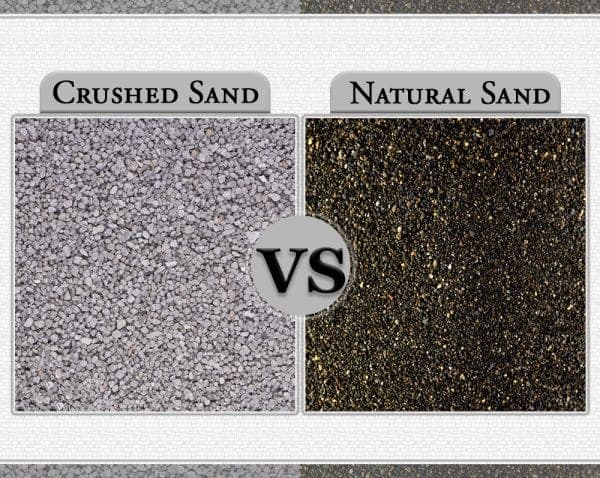
Sand is one of the vital ingredients in construction works. A huge amount of concrete is consumed in construction works.
About 35 % volume of concrete is comprised of sand. Generally, cement and coarse aggregates are factory made products and their quality and standards can be easily controlled and maintained. The sand is usually excavated from river beds or river bank by digging. The natural sand deposits are getting depleted by continuous digging causing damage to the environment in many ways. As the supply of suitable natural sand near the point of consumption is becoming exhausted, the shortage of good natural sand for concrete production is facing challenges. The construction industry has a huge need to solve this challenge. This is also resulting in poor qualities of sand, particularly containing silt. They need to solve this challenge by using crushed sand in construction works. It is a better substitute for natural sand considering increasing demand of sand in construction industry. Hence, here we give you a brief comparison of these materials to help you make the correct choice.

Crushed Sand vs. Natural Sand
01. Source
- The source of Crushed sand is a quarry. It is manufactured by Crushing rocks, quarry stones or larger aggregate pieces into sand size particles in a factory or quarry.
- It is naturally available and extracted from the river banks or river beds.
02. Property
(a) Shape
- The shape of Crushed sand is cubical and angular and has a rough texture and hence better for concrete.
- The shape of natural sand is rounded and has a smooth surface.
(b) Moisture Content
- No moisture content.
- Moisture is generally present in between the particles. Hence, effects the assumptions of concrete mix design and quality of concrete.
(c) Concrete Strength
- The compressive strength as well as the flexural strength of concrete made from Crushed sand are higher than natural sand.
- The compressive strength as well as the flexural strength of concrete made from natural sand are lower than Crushed sand.
(d) Silt Content
- It does not contain silt as it manufacturing by crushing aggregates. However, if screen is not proper sometimes it may contain some dust.
- It contains silt as river water contains it due to erosion of soil in its catchment area. Hence it needs washing on site.
(e) Over Sized Materials
- It is artificially manufactured so there are no oversized materials.
- Oversized materials are expected in natural sand and hence needs screening on site.
(f) Marine Products
- It does not contain any marine products.
- It may contain marine products such as grass, algae, clay lumps, bones, shells, mica etc. which are harmful to properties of concrete.
(g) Eco Friendly
- It causes less damage to the environment as compared to natural sand.
- It is harmful to the environment. It reduces the ground water level and rivers water gets dried up.
(h) Adulteration
- Less adulteration.
- It has high probability of adulteration because of acute shortage. River sand adulteration with saline sea sand is common in coastal areas.
Also Read: Classification of Aggregate shape wise
03. Applications
- It is highly recommended for RCC and brick/ block works.
- It is recommended for RCC, plastering and Brick/Block works
04. Quality
- Better quality as compared to natural sand because it is manufactured in a controlled environment.
- The quality of natural sand deferrers though they may be from the same river bed.
05. Grading Zone
- Manufactured to conform to zone II.
- Mostly conforms to zone II and zone III
06. Bulk Density
- 1.75 Kg/m3
- 1.44 Kg/m3
07. Specific Gravity
- Approximate 2.73 (It will depend on parent rock.)
- Approximate 2.65 (It will depend on rocks in catchment area.)
08. Advantages
- It is an eco-friendly material.
- It gives higher durability and strength to concrete by overcoming deficiencies like segregation, bleeding, honeycombing, voids and capillary.
- Uniformly graded aggregates are available.
- Higher cohesion and compressive strength.
- Better concrete/ mortar quality.
- The slump is less.
- Water retentivity of mortar is less.
- No need to bulkage correction during mix design.
- It is naturally available.
09. Disadvantages
- Crushed sand can be of coarser and angular texture. This can lead to more water and cement requirement to achieve the expected workability.
- Crushed sand contains a larger amount of micro- fine particles. This can affect the strength of concrete.
- The presence of silt and clay in the sand reduces the setting time of cement and make concrete and mortar weak and holds the dampness.
- The requirement of cement is more.
- Water table level get reduced due to dragging of the sand from the river and the roots of the tree may not be able to get water.
- In the absence of sand in river, water gets evaporated due to direct sun light.
- The slump is more.
- Water retentivity of mortar is more.
- Bulkage correction is required during mix design.
- Costly where river are far away.
10. Cost
- It will depend on distance of site from source like river or quarry. But ultimately increased availability of crushed sand plants (it needs special crusher), it will become cheaper as natural river sand. Sand is ultimately scarce material.
- It will depend on distance of site from source like river or quarry. But ultimately increased availability of crushed sand plants (it needs special crusher). Sand is ultimately scarce material.
Special Comments
It is recommended to use crushed sand. It is an economic and ecological alternative to natural sand. Crushed sand possesses properties similar to that of river and is a more sustainable construction material. Scientifically use of crushed sand will provide a long-term solution to construction industry to overcome shortage of river sand.































